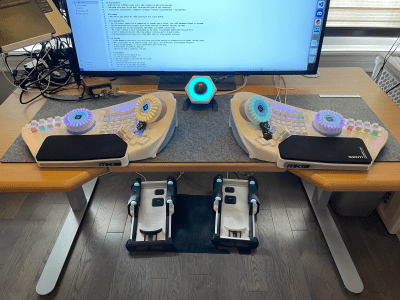We take it for granted that you can look at your phone and tell exactly where you are. At least, as exact as the GPS satellites will allow. But throughout human history, there has been a tremendous desire to know where here is, exactly. Where does my farm end and yours start? Where is the border of my city or country? Suppose you have a flagpole directly in the center of town and a clock tower at the edge of town. You know where they are precisely on a map. You also know how tall they are. What you need is a theodolite, which is an instrument that measures angles very precisely.
Hackaday Columns4556 Articles
This excellent content from the Hackaday writing crew highlights recurring topics and popular series like Linux-Fu, 3D-Printering, Hackaday Links, This Week in Security, Inputs of Interest, Profiles in Science, Retrotechtacular, Ask Hackaday, Teardowns, Reviews, and many more.
Hackaday Links: June 2, 2024
So you say you missed the Great Solar Storm of 2024 along with its attendant aurora? We feel you on that; the light pollution here was too much for decent viewing, and it had been too long a day to make a drive into the deep dark of the countryside survivable. But fear not — the sunspot that raised all the ruckus back at the beginning of May has survived the trip across the far side of the sun and will reappear in early June, mostly intact and ready for business. At least sunspot AR3664 seems like it’s still a force to be reckoned with, having cooked off an X-class flare last Tuesday just as it was coming around from the other side of the Sun. Whether 3664 will be able to stir up another G5 geomagnetic storm remains to be seen, but since it fired off an X-12 flare while it was around the backside, you never know. Your best bet to stay informed in these trying times is the indispensable Dr. Tamitha Skov.
Sometimes It’s Not The Solution
Watching a video about a scratch-built ultra-precise switch for metrology last week reminded me that it’s not always the projects that are the most elegant solutions that I enjoy reading about the most. Sometimes I like reading about hackers’ projects more for the description of the problem they’re facing.
A good problem invites you to brainstorm along. In the case of [Marco Reps]’s switches, for instance, they need to be extraordinarily temperature stable, which means being made out of a single type of metal to avoid unintentional thermocouple joints. And ideally, they should be as cheap as possible. Once you see one good solution, you can’t help but think of others – just reading the comments on that article shows you how inspiring a good problem can be. I’m not worried about these issues in any of my work, but it would be cool to have to.
Similarly, this week, I really liked [Michael Prasthofer]’s deep dive into converting a normal camera into a spectrometer. His solutions were all very elegant, but what was most interesting were the various problems he faced along the way. Things that you just wouldn’t expect end up mattering, like diffraction gratings being differently sensitive across the spectrum when light comes in from different angles. You can learn a lot from other people’s problems.
So, hackers everywhere, please share your problems with us! You think that your application is “too niche” to be of general interest? Maybe it’s another example of a problem that’s unique enough to be interesting just on its own. Let’s see what your up against. A cool problem is at least as interesting as a clever solution.
Hackaday Podcast Episode 273: A Tube Snoot, Dynamic Button Blobs, And Tokamaks Aren’t Whack
This week, it was Kristina’s turn in the hot seat with Editor-in-Chief Elliot Williams. First up in the news: Germany’s solar and wind power generation have resulted in excess energy, which some people think is bad. In Hackaday news, the entries in the 2024 Business Card Challenge are really stacking up.
Then it’s on to What’s That Sound, which Kristina provided this week and managed to stump Elliot. Can you get it? Can you figure it out? Can you guess what’s making that sound? If you can, and your number comes up, you get a special Hackaday Podcast t-shirt.
Then it’s on to the hacks, beginning with an improved spectrometer that wasn’t easy, and a rotary phone kitchen timer that kind of was. We’ll talk about badges turned invitations, reinventing rotary switches, and dynamic button blobs. Finally, we get the lowdown on the state of nuclear fusion, and posit why chatting online isn’t what it used to be.
Check out the links below if you want to follow along, and as always, tell us what you think about this episode in the comments!
This Week In Security: Operation Endgame, Appliance Carnage, And Router Genocide
This week saw an impressive pair of takedowns pulled off by law enforcement agencies around the world. The first was the 911 S5 botnet, Which the FBI is calling “likely the world’s largest botnet ever”. Spreading via fake free VPN services, 911 was actually a massive proxy service for crooks. Most lately, this service was operating under the name “Cloud Router”. As of this week, the service is down, the web domain has been seized, and the alleged mastermind, YunHe Wang, is in custody.
The other takedown is interesting in its own right. Operation Endgame seems to be psychological warfare as well as actual arrests and seizures. The website features animated shorts, a big red countdown clock, and a promise that more is coming. The actual target was the ring that manage malware droppers — sort of middlemen between initial shellcode, and doing something useful with a compromised machine. This initial volley includes four arrests, 100+ servers disrupted, and 2,000+ domains seized.
The arrests happened in Armenia and Ukraine. The messaging around this really seems to be aimed at the rest of the gang that’s out of reach of law enforcement for now. Those criminals may still be anonymous, or operating in places like Russia and China. The unmistakable message is that this operation is coming for the rest of them sooner or later. Continue reading “This Week In Security: Operation Endgame, Appliance Carnage, And Router Genocide”
FLOSS Weekly Episode 785: Designing GUIs And Building Instruments With EEZ
This week Jonathan Bennett chats with Dennis and Goran about EEZ, the series of projects that started with an Open Source programmable power supply, continued with the BB3 modular test bench tool, and continues with EEZ Studio, a GUI design tool for embedded devices.
Continue reading “FLOSS Weekly Episode 785: Designing GUIs And Building Instruments With EEZ”
Keebin’ With Kristina: The One With The Auto Harp Typewriter

You can read all about this version on GitHub, but here’s the gist — you’re looking at a split keyboard with dual macro pads, rotary encoders, and a built-in trackball. And oh yeah, there are pedals, too. Those are a whole other thing.
In this revision, [crazymittens-4] said no to hand-wiring and instead went with custom flexible PCBs. The encoders now have push-button LED screens, and overall, there are “more LEDs than QMK can handle”. There’s even a secret keyboard within the keyboard! I can’t express how much I want to put my hands on this thing.
Continue reading “Keebin’ With Kristina: The One With The Auto Harp Typewriter”

















